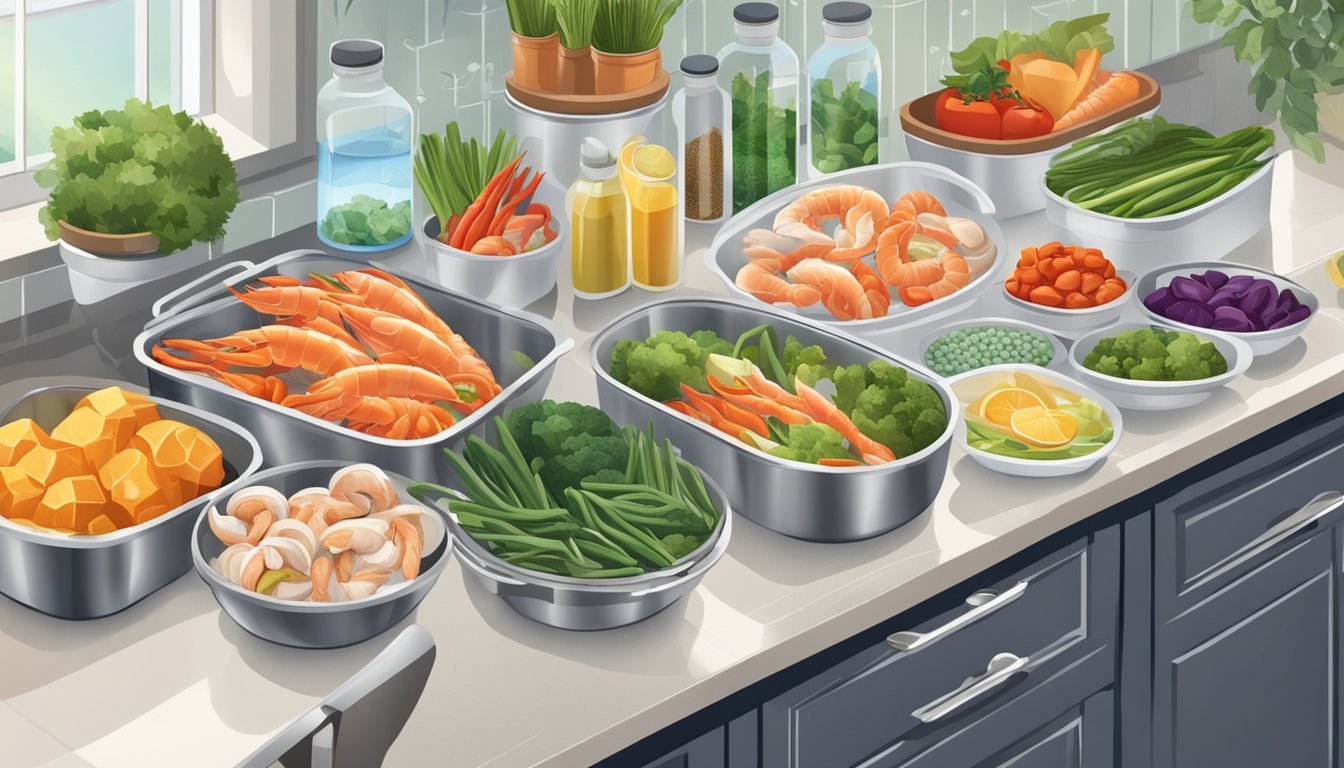The Ultimate Guide to Organizing Your Kitchen for a Pescatarian Diet
Streamlined Storage and Meal Prep Solutions
Organizing a kitchen to accommodate a pescatarian diet involves prioritizing seafood (What wine goes well with seafood?) while maintaining a diverse range of plant-based foods. The pescatarian diet, an eating plan that includes fish and seafood as the primary protein sources alongside fruits, vegetables, grains, nuts, and legumes, is recognized for its health benefits. By focusing on these foods, individuals not only support their own health with essential nutrients like omega-3 fatty acids, which are crucial for heart and brain health, but they also make more environmentally sustainable choices. The emphasis on fish and seafood consumption, as opposed to red meat or poultry, can lead to a reduced environmental impact, as many plant-based components of the diet require less resource-intensive production methods.
As pescatarians, individuals often seek a balance between enjoying the health benefits of the diet and making environmentally conscious choices. This includes selecting seafood from sustainable sources when possible and incorporating a variety of fruits and vegetables that are rich in vitamins and minerals. Omega-3 fatty acids, available in high quantities in many types of fish, play a vital role in overall health.
Creating a pescatarian-friendly kitchen involves strategic organization and stocking of the pantry with grains and legumes, as well as ensuring that fresh produce and seafood options are easily accessible. By centering the kitchen layout and supplies around the principles of a pescatarian diet, individuals can expedite meal preparation and encapsulate the essence of this nutritious and environmentally mindful eating plan.
Understanding Pescatarianism
Adopting a pescatarian diet involves incorporating fish and seafood as primary protein sources while primarily following a vegetarian lifestyle. This section explores what pescatarianism entails, the health benefits it offers, and its implications on environmental sustainability.
Defining the Pescatarian Diet
A pescatarian diet is a plant-based diet that includes fish and seafood. While it eliminates the consumption of land animals, it allows for a variety of marine proteins. This type of diet includes:
Seafood: Fish, shellfish, and other marine life
Vegetarian staples: Grains, legumes, fruits, and vegetables
Dairy and eggs: Included in many pescatarian diets, also known as lacto-ovo pescatarianism
Benefits of a Pescatarian Diet
The health advantages of a pescatarian diet are well-documented and include:
Heart health: High in omega-3 fatty acids from fish, which support cardiovascular health
Weight management and diabetes: Balanced macronutrient profile aiding in weight loss and potentially lowering the risk of diabetes
Complete protein: Fish provides all nine essential amino acids necessary for the body
Environmental Impact and Sustainability
The environmental perspective of a pescatarian diet emphasizes:
Reduced carbon footprint: Compared to a conventional meat diet, pescatarianism typically results in lower greenhouse gas emissions
Sustainability: Ethical pescatarians often choose sustainably sourced seafood to avoid contributing to overfishing
Ecosystem balance: Careful selection of seafood can help maintain marine biodiversity and ecosystem health
Kitchen Organization Fundamentals
A pescatarian diet requires mindful kitchen organization to ensure simplicity in meal preparation and food safety. Efficient use of storage and specialized kitchen tools facilitate this, while proper practices prevent cross-contamination, crucial for both health and ethical reasons.
Essential Storage Tips
Refrigerator: Allocate distinct zones for seafood, ensuring that fish and other seafood are stored in the coldest part of the refrigerator to maintain freshness. Use clear, airtight containers or sealed bags, and label them with the contents and date to keep track of freshness and reduce waste.
Pantry: Designate an area exclusively for pescatarian-friendly items such as grains, legumes, and canned goods. Make use of stackable bins and clear containers to maximize space, provide visibility, and maintain organized access.
Pescatarian-Friendly Kitchen Tools
Equip your kitchen with tools that support a pescatarian diet:
Seafood preparation tools: Include a good-quality fillet knife, seafood scissors, and tweezers for pin-bone removal.
Vegetable-focused gadgets: Spiralizers or vegetable peelers cater to pescatarian cooking, encouraging creativity with plant-based ingredients.
Cooking with purpose: Choose utensils that serve multiple functions to save space and simplify cooking tasks.
Avoiding Cross-Contamination
For health and ethical reasons, preventing cross-contamination is key in a pescatarian kitchen:
Separation: Always use separate cutting boards and knives for seafood and plant-based items.
Cleaning: Thoroughly clean all surfaces, utensils, and kitchen tools after handling seafood to eliminate the risk of bacterial transfer.
Kitchen towels: Regularly launder kitchen towels and sponges to maintain a hygienic environment.
Stocking the Pescatarian Pantry
Establishing a well-stocked pantry is a critical step for anyone following a pescatarian diet. This section will guide readers through the essentials needed in their pantry, optimal seafood selection, and refrigerator staples to maintain a nutritious and diverse pescatarian diet.
Must-Have Pantry Items
A pescatarian pantry should be abundant in whole grains, legumes, nuts, and seeds. These items serve as foundational ingredients for meals, providing essential nutrients and fiber:
Grains: Quinoa, brown rice, and oats are versatile whole grains that offer a base for various dishes.
Legumes: Lentils, chickpeas, and black beans provide protein and texture.
Nuts and Seeds: Almonds, walnuts, chia seeds, and flax seeds are excellent for snacking and adding crunch to meals.
Oils and Spices: Olive oil and coconut oil are key for cooking, while a range of spices (turmeric, paprika, garlic powder) bring flavor and health benefits.
Selecting Your Seafood
When choosing seafood, it's important to consider variety and sustainability. Incorporating fatty fish rich in omega-3s, such as salmon and mackerel, supports a healthy diet. Opt for:
Low-Mercury Fish: Such as tilapia and cod, to minimize potential mercury exposure.
Sustainable Seafood: Choices certified by organizations like the Marine Stewardship Council protect ocean life.
Shellfish: Including shrimp and mussels, (What wine goes well with mussels?) offer diverse textures and flavors.
Fatty Fish Low-Mercury Fish Shellfish Salmon Tilapia Shrimp Mackerel Cod Mussels
Refrigerator Essentials
The pescatarian refrigerator should be stocked with perishable items that round out the diet:
Seafood: Fresh or frozen selections, depending on preference and availability.
Dairy: Milk, cheese, and yogurt provide calcium and protein.
Eggs and Tofu: Serve as versatile protein sources for any meal.
Fruits and Vegetables: A colorful array of produce ensures a variety of vitamins and minerals.
Leafy Greens: Spinach and kale are high in calcium and other crucial nutrients.
Maintaining a well-stocked kitchen helps ensure that individuals can create nutritious, pescatarian-friendly meals with ease.
Strategic Meal Planning
When one organizes their kitchen for a pescatarian diet, strategic meal planning becomes essential. It ensures nutritional balance, variety in meals, and efficiency in cooking and meal preparation.
Crafting Balanced Meals
To achieve a well-rounded pescatarian diet, one must include a variety of proteins, iron-rich foods, an abundance of vegetables, and sources of healthy fats. Balancing these nutrients is vital for maintaining health and energy levels.
Proteins: Including a variety of fish and seafood ensures intake of essential amino acids.
Iron: Incorporate legumes, spinach, and fortified cereals to meet iron requirements.
Vegetables: Aim for a colorful plate with a mix of leafy greens and other vegetables to maximize nutrient intake.
Healthy Fats: Use olive oil in dressings and for cooking, and include nuts and seeds for snacking.
Pescatarian Recipes and Cooking Tips
The success of a pescatarian diet often hinges on having an arsenal of tasty and nutritious recipes.
Cooking with Olive Oil: Olive oil is a staple in pescatarian cooking, not only for its healthy fats but also for its ability to enhance the taste of fish and vegetables.
Flavor Infusion: To infuse depth of flavor into seafood, consider simmering proteins in robust sauces, like tomato sauce seasoned with cinnamon and cumin, for an aromatic twist.
Recipe Resourcefulness: Gather recipes from reliable sources, ensuring they are friendly to pescatarian preferences and constraints.
Meal Prepping Strategies
Efficiency in meal prep is crucial for those with a busy lifestyle.
Time-Saving Tips:
Plan meals that share similar ingredients to reduce preparation time and grocery shopping frequency.
Prepare proteins in advance: Cook fish in large batches to be used throughout the week.
Cut and store vegetables beforehand to streamline the cooking process on busy days.
By implementing these strategic meal planning practices, one can maintain a varied and nutritious pescatarian diet while optimizing kitchen efficiency.
Health Considerations in a Pescatarian Diet
Choosing a pescatarian diet involves careful consideration of nutritional balance, ideal fish intake, and the potential for disease prevention. Heeding these areas ensures the maintenance of optimum health while adhering to this dietary choice.
Addressing Nutritional Needs
A pescatarian diet offers a generous supply of omega-3 fatty acids, which are pivotal in promoting heart health and reducing inflammation. Foods like sardines, mackerel, and tuna (What wine goes well with tuna?) are rich in these fatty acids. In addition to omega-3s, the diet supplies a variety of protein sources from fish and plant-based foods such as legumes and nuts. A challenge within the pescatarian diet is ensuring adequate intake of vitamin B12, zinc, and iron, which are less available in plant-based sources and are crucial for various bodily functions. It's recommended to include:
Fortified cereals or supplements for vitamin B12
Seeds, nuts, and whole grains for zinc
Spinach, lentils, and tofu for iron
Managing Mercury Intake
With a diet rich in seafood, managing mercury intake is vital. High levels of mercury, prevalent in certain larger and longer-lived fish, can be detrimental. People should select seafood with low mercury content, like:
Low Mercury Fish Higher Mercury Fish Sardines King Mackerel Trout Swordfish Atlantic Mackerel Shark Herring Tuna
Limiting consumption of fish with higher mercury content is particularly important for pregnant individuals and young children.
Pescatarian Diet and Disease Prevention
Research indicates that a pescatarian diet can be associated with a lower risk of lifestyle-related diseases. Regular consumption of fish and plant-based foods can contribute to lower blood pressure and a reduced risk of type 2 diabetes. Several studies suggest that pescatarians might also have a lower incidence of obesity, certain types of cancer, and sudden cardiac death, compared to those following meat-inclusive diets. However, these health outcomes rely not only on diet but also on an overall lifestyle that includes physical activity and the avoidance of tobacco and excessive alcohol use.






